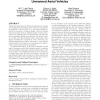Free Online Productivity Tools
i2Speak
i2Symbol
i2OCR
iTex2Img
iWeb2Print
iWeb2Shot
i2Type
iPdf2Split
iPdf2Merge
i2Bopomofo
i2Arabic
i2Style
i2Image
i2PDF
iLatex2Rtf
Sci2ools
ATAL
2015
Springer
2015
Springer
Observation Modelling for Vision-Based Target Search by Unmanned Aerial Vehicles
Unmanned Aerial Vehicles (UAVs) are playing an increasing role in gathering information about objects on the ground. In particular, a key problem is to detect and classify objects from a sequence of camera images. However, existing systems typically adopt an idealised model of sensor observations, by assuming they are independent, and take the form of maximum likelihood predictions of an object’s class. In contrast, real vision systems produce output that can be highly correlated and corrupted by noise. Therefore, traditional approaches can lead to inaccurate or overconfident results, which in turn lead to poor decisions about what to observe next to improve these predictions. To address these issues, we develop a Gaussian Process based observation model that characterises the correlation between classifier outputs as a function of UAV position. We then use this to fuse classifier observations from a sequence of images and to plan the UAV’s movements. In both real and simulated...
| Added | 16 Apr 2016 |
| Updated | 16 Apr 2016 |
| Type | Journal |
| Year | 2015 |
| Where | ATAL |
| Authors | W. T. Luke Teacy, Simon J. Julier, Renzo De Nardi, Alex Rogers, Nicholas R. Jennings |
Comments (0)

